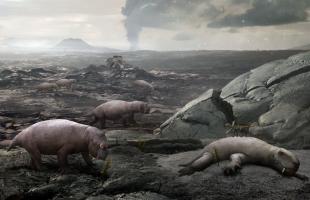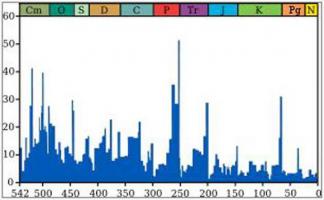10-Accretion of Mass

External accretion of extraterrestrial mass is irrefutable. Everyone knows about meteors and meteor showers that regularly enhance the night skies at certain times each year. Meteorites, the solid remnants of meteors that land on Earth, are also known to almost everyone, even though few may have actually seen one.
Every meteoroid (they come in all sizes, from small particles, to pebbles, to small rocks, and megaton meteorites) striking Earth's atmosphere at night creates a visible luminescent "shooting star" trail that indicates frictional ablation during its transit of the atmosphere. This is a visual signal of mass being added to Earth's surface. Whether or not a meteorite, or just its ablated dust particles, reaches the ground depends on its original size, its molecular composition, its angle of entry, and the depth and density of the atmosphere.
Hard evidence of external accretion of mass is shown graphically in the Grand Canyon diagram showing successive layers of different types of sediments deposited at the rate of ~2m/Ma over ~500 Ma to a depth of one kilometer. Each layer was once exposed to the sun when it was Earth's surface, but now only the edge of each layer is exposed to the sun by erosion that created today's Grand Canyon.

Similarly, worldwide coal deposits and palaeontology digs, millions of years old, are now covered by deep layers of overburden that did not accrete overnight. People overlook the obvious fact that such immense volumes of overburden must have been laid down gradually and successively in subsequent millennia. Each stratum in any geologic formation, whether a mountain range or a coal deposit deep below ground, had its own "day in the sun" millions of years ago before it was buried by subsequent accretion of matter from outer space.
Today's atmosphere is denser and thicker than it was millions of years ago when Earth was much smaller, so fewer meteoroids result in large meteorites; most of them are converted by ablation into meteor dust that has a 75% chance of settling onto some body of water. This is the source of most of the deep sediments now covering the oceans' floors. Only the largest survive their fiery transit to become meteorites, but it happens frequently, and more often than most people realize.
One of the most recent reports was of a 2.2 lb (1 kg) meteorite that fell 22 March 1998 about 40 feet from a group of boys playing basketball in Monahans, Texas. NASA is now studying the meteorite as a potential source of water because it contains halite crystals. However, it is fairly well known that rocks in general contain about 8-10% H2O, which is the probable source of all the water now on the surface of the planet.
The Moon's surface provides the best evidence we have that space is filled with fine dust particles. Neil Armstrong's boot prints at the base of the lunar lander and dust and dirt kicked up by cavorting astronauts proved that the Moon's surface is covered by very fine, powdery dust particles, particles that are not products of atmospheric ablation because the Moon has no atmosphere.
The photo below of the astronaut drilling for a sample of moon rock from the large boulder in the foreground shows considerable soil atop the rock itself, and the surrounding area is covered with rocks of various sizes partially buried by fine dust and soil particles.

High-resolution photos of the Moon show many large impact craters with smooth floors that are now pocked by subsequent smaller impact craters, which implies that massive accretion of dust has filled in the original crater since it was first formed. In the same way, extraterrestrial dust continues to accrete onto Earth's surface today, with a 75% chance of landing on some body of water, accounting for most of today's kilometers-thick ocean sediments.
The daily influx of meteorites and meteor dust is well known to scientists, but the total volume of mass daily added to Earth's surface is difficult to estimate and is not well documented. Estimates of total volume published by NASA vary widely (or wildly?) just for dust alone, ranging from as little as 1,000 tons/day (300,000 metric tons/yr, Dubin and McCracken, 1962) to 55,000 tons/day (20,000,000 tons/yr, Fiocco and Colombo, 1964). However, a more recent estimate puts the accreting dust volume at approximately 78,000 tons/yr, or 214 tons/day.
Such a wide variance in estimates is a good indication that no one really knows the true figure. Furthermore, it is highly probable that the daily volume has fluctuated over time, and there is no firm agreement on the age of the Earth that would provide a basis for calculation of an average daily influx, although the Grand Canyon layers appear to have been laid down at the rate of 2m/Ma.
Using ages shown in the Grand Canyon walls, it took ~500 Ma to build up only one kilometer of depth, and beneath that are another 25-40 kilometers of older continental crust, so it is easy to arrive at an age of the Earth much greater than the 4.6 billion years now estimated. Age-dating meteorites without any knowledge of their origin has little value because it only provides an age for that specimen.
The potential volume of accreted extraterrestrial material can be imagined from the estimates of Terentjeva that just the ten major meteor streams (the largest being the Quadrantids, Perseids, Orionids and Geminids) produce from 10-100 meteor impacts per hour for several days every year. Terentjeva also reported an additional 374 minor streams (154 of them with appreciable numbers) crossing Earth's orbital path annually "with a duration of not less than 3 to 7 days and an average rate not exceeding 2 meteors per hour."
These numbers may not seem large or significant, but they represent additional volumes of extraterrestrial matter that must not be discounted. These estimates also do not include countless numbers detectable by radar in daylight, with or without atmospheric impact; or larger meteorites that pass through or glance off Earth's atmospheric envelope and may return to strike the Earth, Moon, or Mars on next year's transit.
Then there are the larger and more massive meteorites that far outweigh any volumes of dust. Remnants of larger meteors often survive Earth's atmospheric friction and reach Earth’s surface to become known as meteorites. Known meteorites come in all shapes and sizes, including multi-ton monsters found in museums, even a large one of pure copper, and smaller ones of pure gold, but only 10% are of nickel-iron composition and immediately recognizable as being extraterrestrial in origin. The other 90% of Earth's meteorites are chondrites and usually indistinguishable from ordinary field stones because that's what they are.
Despite the public’s current perception that large meteorites are rare, they are actually quite common in terms of geologic time. Chicxulub Crater in the Gulf of Mexico has been touted as the cause for demise of the dinosaurs 65 million years ago. Barringer Meteor Crater near Flagstaff, Arizona, is 1.186 km in diameter and is estimated to have been created only 50,000 years ago. Manicouagin Crater in Canada is about 100 km in diameter and is estimated to be ~215 Ma in age. Shields (1981) lists 21 impact craters ranging from 243 to 1100 km in diameter, and a quick search on the internet will disclose others that are not well known.
From the author's personal knowledge, Little Round Bay at Long Point on the Severn River, near Annapolis, Maryland, is a meteorite impact site. Little Round Bay is circular with a small rebound island in the middle, typical of meteorite craters, and the surrounding area slopes inward to Little Round Bay.
These, and many other impact craters, are just the few we know about. Most older impact craters are hidden by accreted dust ablated by Earth's atmosphere, which is now far more dense than it was in earlier epochs when Earth was the size of Mars and meteorites were free to strike with full force and mass with little atmospheric ablation. What would the Earth's surface have looked like 200 million years ago when its atmosphere was much thinner? (For examples, look at panoramic views of craters on the Moon and meteorites scattered about Mars’ surface.)
For other examples, the author suggests that Hudson's Bay is a major impact crater from an earlier period. Hudson's Bay has been identified by Schultz, Klasner and Cannon (1982) as a probable impact crater from concentric gravity rings extending 1700 miles from Hudson's Bay to the Great Lakes. The Great Lakes and the great iron ore and nickel deposits are also evidence of a meteoritic origin.
A North Polar projection map shows the Arctic Circle encloses what appears to be an immense circular impact structure. Greenland and the northernmost area of Canada, as well as the Brooks Range in Alaska, may be artifacts of an asteroid that may have formed the roughly circular Arctic Ocean shores of Siberia. The author speculates that, if this site could be proved to be an asteroid impact crater and dated as a fairly recent event, the huge size might qualify it as a candidate for the event that knocked the Earth into its present 23.5° inclination from the ecliptic, leaving behind flash-frozen mammoths with tropical vegetation in their mouths. (This is only one of several possibilities. Fixing the approximate date of such an impact is crucial in connecting the event to other known geologic events, as will be seen in the next segment.)

Note
This is part 11 of a series of articles written by Lawrence S. Myers in the late 1990s on the Expanding Earth theory. Click "next" to read the subsequent article.























